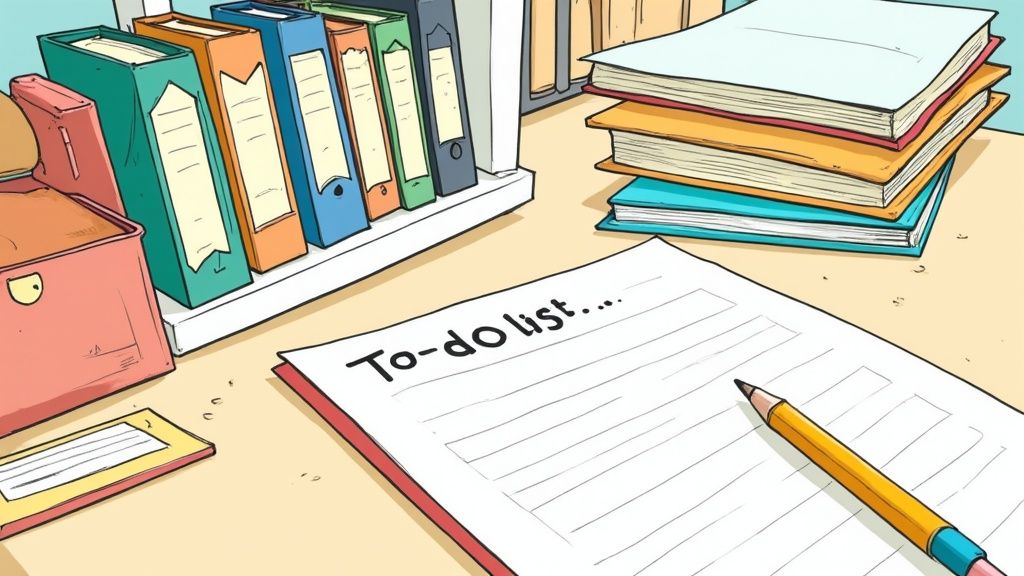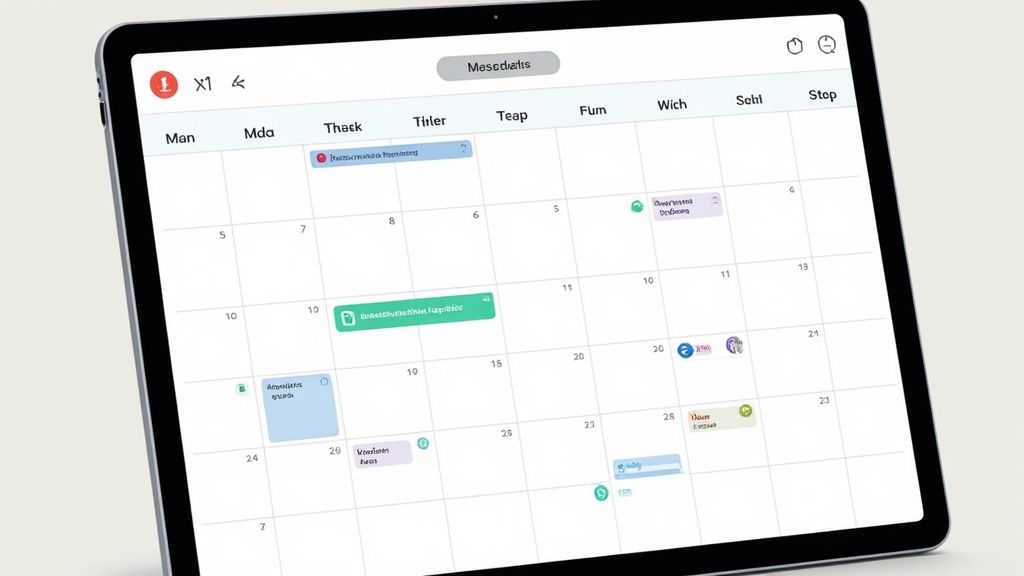How to Organize Work Tasks: The Complete Productivity Blueprint
Learn proven strategies to effectively organize work tasks, boost productivity, and achieve more in less time. Discover expert guidance for building a sustainable task management system that creates lasting results. meta t: How to Organize Work Tasks: The Complete Productivity Blueprint published: No slug: how-to-organize-work-tasks
Organizing Work Tasks in Modern Organizations
The way we organize work has fundamentally changed. Basic to-do lists no longer serve us well when faced with endless notifications, shifting deadlines, and information overload. This isn't about personal discipline - the very structure of work demands better solutions for managing tasks and time.
Problems With Basic Task Management
Simple task lists can quickly become overwhelming. They don't help distinguish truly important work from urgent distractions, which leads to constantly reacting to "emergencies" rather than progressing on key goals. Think of it like having a list of street names without a map - you might be moving, but not necessarily in the right direction.
Many people and teams struggle to set clear priorities. They spread their efforts too thin across multiple projects without making meaningful progress on any single one. Like trying to juggle too many balls at once, you expend energy but achieve little forward momentum.
Why Tasks Remain Unfinished
The data on task completion rates reveals concerning trends. According to recent research, employees complete only 53.5% of their planned weekly tasks on average. The numbers are even more striking at the team level - just 16.8% of teams finish more than 70% of planned work, while 31.1% complete less than 40%. See the full analysis here: Task Management Trends Report.
These low completion rates connect directly to human psychology. Unfinished tasks create mental clutter and stress. The Zeigarnik Effect shows that incomplete work stays active in our minds, making it harder to focus on other priorities. This mental burden drains our energy and reduces overall output.
Building Better Task Systems
Moving beyond basic to-do lists requires a structured yet flexible approach to managing work. An effective system should help you:
Set clear priorities
Use time efficiently
Stay focused despite distractions
Make informed decisions about what to take on, delegate, or decline
The key is shifting from reactive task management to proactive planning. This mindset change enables better results in complex work environments.
Creating Your Personal Task Management Framework
Managing tasks well means going beyond simple lists. A personal task management framework is a complete system that helps you track, sort, and complete tasks in a way that fits your natural work patterns. Just like building a house, you need strong fundamentals before adding complexity.
Choosing the Right Methodology
Here are some proven task management approaches to consider:
The Eisenhower Matrix: Sort tasks into four boxes based on urgency and importance. This simple but powerful tool helps prevent overwhelm by making it clear what needs your attention first.
Getting Things Done (GTD): The GTD method focuses on collecting all tasks in one place and breaking them into concrete next actions. It works especially well for handling multiple complex projects.
Kanban: A visual board showing tasks moving from "To Do" through "In Progress" to "Done." Great for seeing project status at a glance and managing team workflows.
Try different methods and mix elements that work for you. The best system is one that matches your specific needs and work style.
Prioritization and Categorization
Success with task management comes down to two key skills: prioritization and categorization. Good prioritization ensures you tackle high-impact work first, while smart categorization keeps everything organized.
Many people struggle without a clear system. Research shows that 82% of workers don't use formal time management, leading to 51% of time spent on low-value activities. See more data here: Time Management Statistics.
Try using tools like the Eisenhower Matrix to rank tasks by importance and urgency. Group related tasks by project, location (home/work), or energy level needed.

Building a Sustainable System
The best task management system is one you'll actually stick with long-term. Start simple, test different approaches, and regularly check that your system still fits your needs. By fine-tuning your methods over time, you'll develop habits that truly help you get more done with less stress.
Making Technology Work For You

Good task management relies on having the right digital tools, but quality matters more than quantity. The goal is to build a focused set of tools that makes your work easier, not more complex. Think of it like picking the perfect tools for a specific job - you want just what you need, nothing more.
Finding Tools That Fit Your Needs
Start by looking at where you struggle with task management. Maybe you have trouble keeping track of deadlines, collaborating with others, or just staying organized. Understanding these pain points helps you pick tools that actually solve your problems.
Take Obsibrain as an example - it combines task tracking, habit building, and planning in one place. This helps reduce the mental drain of switching between multiple apps throughout the day.
When choosing tools, focus on three key factors: how easy they are to use, whether they work with your current apps, and if they fit your budget. Simple tools that integrate well often work better than complex ones with lots of features.
Making Tasks Run on Autopilot
Smart automation can free up your time for important work. Simple things like setting up recurring tasks, using templates, and creating automatic reminders can save significant time each day.
The numbers back this up - research shows that 78% of workers get more done when they automate routine tasks, saving about 3.3 hours every week. Plus, 67% of employees work better with set hours and clear boundaries between work and personal time. See more data at Workplace Statistics - Deel. These findings show how the right tech tools can help create better work patterns.
Getting Your Tools to Work Together
While good tools help, too many can create confusion. The key is making them work together smoothly. Pick tools that connect well, avoid overlap in features, and share information easily.
Think of your tools like instruments in a band - each one has its role, and you're the conductor making sure they play well together. Start small with automation, keep the human element in your workflow, and build up gradually. This helps create a system that supports your work without taking over.
The Art and Science of Task Prioritization
Properly prioritizing tasks shapes how well you achieve your goals and get things done. The key is understanding the core difference between urgent tasks that need immediate attention and important tasks that advance your long-term objectives. Let's explore how to blend practical methods with sound decision-making.
Using Time-Tested Prioritization Methods
The right prioritization framework makes organizing tasks much easier. The Eisenhower Matrix lets you map tasks into four clear categories based on urgency and importance: "Do" (act now), "Schedule" (plan for later), "Delegate" (assign to others), and "Delete" (eliminate). This simple but powerful method helps you stay focused on meaningful work rather than getting lost in busywork. Another great option is the Getting Things Done (GTD) approach - capture everything, break it down into next actions, and sort by context. This creates a clear system for handling your workflow.
Setting Clear Priority Guidelines
Good prioritization needs consistent criteria. Consider key questions: Which tasks directly support my main goals? What will have the biggest positive impact? Look at factors like dependencies (required order of tasks), effort needed, and potential impact. For instance, if you're working on a critical product update, the development and testing should take precedence over less essential work. Having these guidelines prevents decision overload and maintains your focus.
Staying Flexible While Keeping Your Goals in Sight
Plans often need adjusting as circumstances change. New projects come up, timelines shift, and unexpected issues demand attention. Your prioritization system should flex with these changes. Regular reviews help ensure your priorities still align with your objectives. Tools like Obsibrain make this easier with built-in task management and adaptable project frameworks. By combining proven methods like P.A.R.A. and SMART goals, you can smoothly adjust priorities while tracking your progress. This balance between handling daily needs and pursuing long-term goals is what makes task prioritization work.
Building Powerful Review and Adaptation Systems

A strong task management system needs regular attention and updates to stay useful. Like tending a garden, your system requires consistent care to keep producing results. Let's explore how to create review systems that help your task management stay fresh and practical.
Implementing a Review Cadence
Having regular check-ins at different intervals helps keep your task system running smoothly. These reviews let you see what's working, spot problems early, and make needed adjustments based on real results.
Daily Review: Take 5-10 minutes at day's end to clear completed items, set priorities for tomorrow, and catch any missing tasks. This quick habit prevents small issues from becoming big problems.
Weekly Review: Set aside 30 minutes each week for a broader look at your progress. Check how you're doing on bigger goals, spot any upcoming challenges, and adjust next week's plan accordingly.
Monthly Review: Once a month, take an hour to look at the big picture. Study your patterns, check if your system still fits your needs, and make bigger changes if needed. Tools like Obsibrain have features built in to make these reviews easier.
Measuring Success and Identifying Opportunities
Reviews aren't just about checking off tasks - they help you see if your system actually works. Look at whether you're handling the most important work first, using your time well, and moving toward your main goals. Ask yourself: Are you finishing the tasks that really matter? Or are you stuck dealing with urgent problems while important projects sit untouched?
Adapting to Change and Maintaining Accountability
Your work changes over time, so your task system should too. What worked perfectly last year might not fit your needs now. Regular reviews help you spot when it's time for changes, try new methods, and keep your system matching your current situation. Having someone to check in with - whether it's a coworker or just tracking your own progress - helps build lasting habits. This accountability ensures your task management system keeps helping you reach your goals.
Launching Your Enhanced Task System

Setting up a new task management approach takes more than picking methods and tools. Like mastering any skill, it needs steady practice and fine-tuning. Success comes from weaving the system into your daily work and making adjustments based on what you learn.
Transitioning to Your New System
When you first switch task systems, it can feel a bit rocky. Start small by testing one piece of your new approach on a single project. For example, if you're trying the Eisenhower Matrix, use it just for your main project first. Set aside 15-30 minutes each day to work with your new system - this helps build it into your routine naturally.
Overcoming Common Obstacles
New systems often come with speed bumps. You might catch yourself falling back into old patterns or feeling swamped by new processes. Rather than getting frustrated, plan ahead for these moments. Find a work buddy who can check in on your progress, or use a simple app to track your consistency. Having this support makes a big difference.
Adapting to Your Work Environment
Every workplace has its own rhythm and needs. Your task system should fit your specific situation and team setup. Think about how you work best - if you're in a team that moves quickly and works together often, try a Kanban board approach. It helps everyone see what's happening and share updates easily.
Building Long-Term Habits
Making your new system stick means turning it into a natural part of your workday. Good tools can help here. For instance, Obsibrain keeps your tasks, habits, and plans all in one spot in your Obsidian workspace. This makes it simple to stay on track. Check in on your system every week or two - see what's working well and what needs tweaking to match your changing needs.
Want to make your work easier to manage? Obsibrain helps you organize tasks, build good habits, and get more done. Try Obsibrain free today and see the difference it makes.
Last updated
Was this helpful?